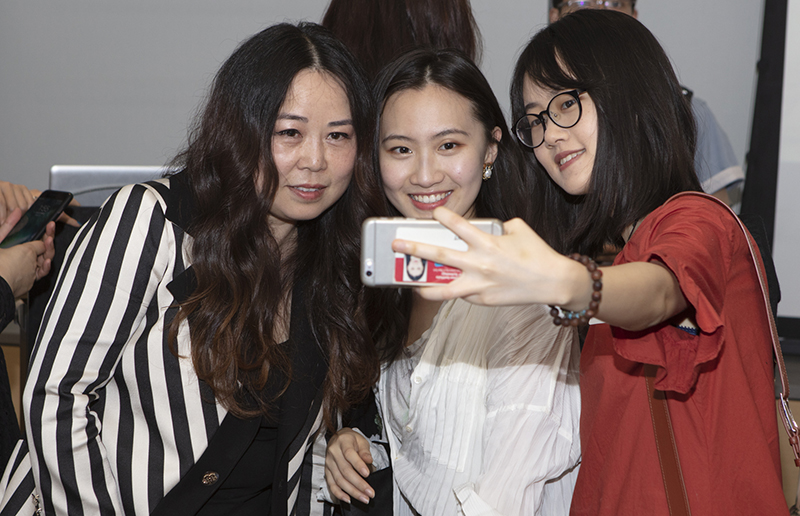

East meets West in the designs of couturier Grace Chen ’96, and in her hands that encounter is dynamic and transformative. Her namesake house is based in Shanghai, but you won’t find traditional garments like cheongsams, or images of dragons or pagodas in her line. She has a deep knowledge of Chinese history and craft, but she’s equally at home with references to the Bauhaus and the golden age of Hollywood. If global identity is the future, Chen’s ingeniously blended aesthetic illustrates how that might look.
During a visit to FIT in 2018, Chen sat down with Hue for a conversation about her experience at the college, her business, and contemporary Chinese style. As the country forges its identity in the global economy, its fashion is also changing. The days of clothing “made in China” (but designed elsewhere) may be ending. According to The Economist, an estimated two-thirds of the richest self-made women in the world today are Chinese, and as Chen points out, most Western fashion suits them awkwardly. Newly ascendant, Chinese couture is stepping in to fill the void. Her clients include actor Qin Hailu; Gina Qiao, senior vice president of the tech firm Lenovo; and, allegedly, China’s first lady Peng Liyuan. Prices range from $3,000 to $12,000 per dress, or more.
Chen already had a fashion design degree from Beijing University when she arrived at FIT in the mid-90s, and she took to the American industry avidly. After graduation, she worked for Halston in New York, then for Japanese designer Tadashi Shoji in L.A. Of the celebrities she outfitted—Oprah Winfrey, Helen Mirren—Chen says, “For me, they are just women. They all worry about their legs, waists, and face. My job is to make them more beautiful than they are.” In 2009, she founded her company in Shanghai; an early collection, “Little Red Dress,” caused a sensation. In 2016, the designer opened a new space in an Art Deco mansion in Shanghai’s French Concession district. The prestigious architecture firm Kokaistudios renovated the space to encompass a showroom, gallery, fitting rooms, offices, dining room, and a library, as well as a VIP suite for a full lifestyle experience. With that bold stroke, Grace Chen Couture had arrived.

A conversation with Grace Chen
Hue: When you came to New York to study at FIT, did you experience culture shock?
Chen: Never. I feel like this was my home in a former life. What was it like to leave China? At that time, it was very difficult to get a passport or visa, to get out of the country to study. It was actually a groundbreaking thing.
I understand that FIT helped you particularly with the business side of fashion.
The school has a sensibility about product, management, production; that’s more difficult than design. I mean, people ask me how you get inspiration, but you either have the creative part or you don’t. I’m a realist, not just an artist. At FIT you learn how to make your dream into a brand. That’s what you need to learn.
How is the American industry different from China’s?
In America it’s divided into many different areas focusing on people’s lifestyle, and it’s complicated by demographic difference, and even divided by body types. So it’s an intricate system, but it’s very functional. That’s what China doesn’t have.
China has manufactured mass fashion for years. What’s missing?
Production-wise, yes, over the last 20 or 30 years there are a lot of really great factories, no less than in Europe or America. But how do you make a product relate to people’s life? Like, say, a professional woman—work wear? In China, it’s very difficult to find this kind of clothes.
Why is that?
Because it’s much more difficult to make than casual wear. First, the design has to be simple, and it’s more difficult to design simple things than complicated stuff. You have to have really good taste, technology, and patternmaking skills. It has to be beautiful, easy, and comfortable to wear. A good brand can do that, and we don’t have that.
You told CNBC, “It’s time for China to find its fashion identity.” What did you mean?
This is what brought me back to China to establish this brand. Why is it always Paris trends, London, or Tokyo? Can Chinese wear them nicely? Obviously not! The body, the posture, the whole meaning behind that fashion is completely wrong. Maybe something like Nike shoes, Gap, all these casual things, I guess it’s fine. But if you really want to wear fashion in a meaningful way, to represent yourself, your background or lifestyle, it will be much more than that. So I have two challenges—good clothing for Chinese and good style coming from China for the world.
How does that translate into an aesthetic?
Our style has a softness. It goes with the person. It’s kind of like penetrating into you, instead of just a shell outside of you. We use a lot of fringes, a lot of tassels. This is typical Chinese philosophy; you use soft to conquer the hardness. The soft is more powerful than hard. But meanwhile, it has a strength. Part of that strength is Western, and part of it is Chinese women’s inner strength.
Your mansion in Shanghai looks fabulous. What does it signify?
In China, I can’t just focus on the clothing itself. I have to educate the customers. In New York, when you see a woman in a Grace Chen dress, immediately you have a picture of her lifestyle: She will have a grand house in Connecticut or an apartment on Fifth Avenue. But in China, nobody would know. That’s why I need a mansion: to demonstrate the lifestyle of a Grace Chen woman.